Robust Course Keeping Control of a Fully Submerged Hydrofoil Vessel without Velocity Measurement: An Iterative Learning Approach
Abstract
This paper proposes a novel robust output feedback control methodology for the course keeping control of a fully submerged hydrofoil vessel. Based on a sampled-data iterative learning strategy, an iterative learning observer is established for the estimation of system states and the generalized disturbances. With the state observer, a feedback linearized iterative sliding mode controller is designed for the stabilization of the lateral dynamics of the fully submerged hydrofoil vessel. The stability of the overall closed-loop system is analyzed based on Lyapunov stability theory. Comparative simulation results verify the effectiveness of the proposed control scheme and show the dominance of the disturbance rejection performance.
1. Introduction
As an advanced marine vehicle, the fully submerged hydrofoil vessel (FSHV) can cruise at a high speed against rough sea waves. The lift force of the hydrofoils generated by the high-speed fluid elevates the ship hull up from the water, which highly reduces the wave resistance and friction on the ship. However, the lift force also destabilizes the open-loop system of the FSHV. Therefore, it is necessary to equip an autopilot for this type of marine vehicles [1–3]. Currently, the commercial control systems equipped on board are based on optimal control theory [4], which has a weak disturbance rejection property. For the sake of the high cruising speed, the nonlinear hydrodynamic damping of the FSHV cannot be neglected [5, 6]. Therefore, the widely used linear model of marine surface vessels is no longer applicable given the strong coupling between yaw and roll dynamics. Moreover, the model uncertainties and disturbances caused by wind, waves, and currents prevent precise steering of this species of marine vehicle.
The path of marine surface vehicles is usually a straight line or straight lines formed by waypoints at the open sea. Hence, there is little coupling between the longitudinal dynamics and the lateral dynamics. Some literatures present the riding control design of the FSHV [4, 7]. This paper mainly focuses on the steering control of the FSHV.
For the nonlinear steering control of marine vessels, a series of control methodologies have been proposed, such as advanced sliding mode control [8–10], robust control [11, 12], and adaptive control [13, 14]. But these passive disturbance attenuation control methods may suffer from actuator chattering, system conservation, derivative explosion, and rigorous proof for stability. Intelligent approximation tools such as neural network, fuzzy logic, and SVM are introduced as feedforward components for state estimate and disturbance compensation, but the convergence rate of weight function and the problem of extremum solving still remain to be settled [6, 12].
Disturbance rejection control is also widely used in applications of rigid body dynamics and servo systems [15–17]. Disturbance observer based control (DOBC) approaches provide an active way to handle disturbances and improve the robustness of the closed-loop systems. The effectiveness of DOBC has been shown in many fields such as manipulator tracking control [18], missile guidance and control [19–21], and motor control [22, 23]. However, traditional DOB methodology cannot be used in nonlinear dynamics due to the limitation of linear system theory, and the low pass filter must be designed strictly such that the convergence of the disturbance estimate can be guaranteed [16].
- (1)
In most control engineering applications, the system structures do not match these observers very well, so the observers require complicated coordinated transformations.
- (2)
Many state observer methodologies are designed for SISO systems, but the practicality and stability of these methodologies for MIMO systems still need to be further discussed.
- (3)
Most of these observers estimate only the system states, while the disturbance estimate could not be overall considered.
The course keeping control of the FSHV suffers severely from model uncertainties and wave disturbances. Therefore, it is of great necessity to design an observer which is able to estimate system states as well as the generalized disturbances integratedly. Furthermore, in order to guarantee the disturbance rejection performance of the control scheme, the feedback controller of the inner loop should also achieve disturbance attenuation properties, such that the residual error of the disturbance estimate can be compensated through a composite strategy.
In this paper, a novel output feedback control methodology is proposed for the course keeping control of the FSHV based on a sampled-data iterative learning approach. An iterative learning observer is established for the state estimation as well as generalized disturbances. Then a sliding model controller with an iterative learning sliding manifold is presented for the stabilization of the lateral dynamics of the FSHV. The design of the iterative sliding surface introduces a memory effect for the controller, which includes both the current and past information of the system states and outperforms the standard sliding mode control in the improvement of the transient performance.
The rest of the paper is organized as follows. In Section 2, the mathematical model of the lateral dynamics of the FSHV is established. In Section 3, an observer based sliding mode control is proposed based on iterative learning approach. Then we analyze the Lyapunov stability of the overall closed-loop system in Section 4. Simulation is carried out in Section 5 to validate the effectiveness of the proposed methodology, followed by Conclusions in Section 6.
2. Problem Formulation
A typical configuration of a fully submerged hydrofoil vessel is shown in Figure 1 [4]. The T-shaped bow foil is equipped with two controlled flaps, acting together. The aft foil has a pair of central flaps and two pairs of ailerons. Struts of the aft foil are equipped with rudders, which are used for roll and yaw dynamics together with the ailerons. The bow foil and the central part of the aft foil are for longitudinal motion control.

Course keeping control, or so-called ship heading control, is the primary task of the autopilots of ships. The control objective of course keeping control is to stabilize the yaw angle to a desired heading angle. As to the course keeping control for conventional marine surface vessels, the roll dynamics is rarely considered due to the weakness of the control actuators for roll dynamics. The roll restoring moments provide static stability, which the FSHV does not have. Therefore, it is necessary to take the roll dynamics into consideration for the course keeping control design for the FSHV.
Remark 1. When ships sail at a fixed speed, M(·), C(·), DL(·), and G(·) are linear matrices with constant element parameters, so F0(x1, x2) is also a linear function, while ζ0(x1, x2) represents the nonlinear damping of the coupling hydrodynamics of the FSHV.
Hence, the control objective is to design an observer based output feedback controller for the course keeping of the FSHV using an iterative learning approach. The control structure of the system is summarized in Figure 2. For the subsequent analysis, the following assumptions are carried out for convenience.
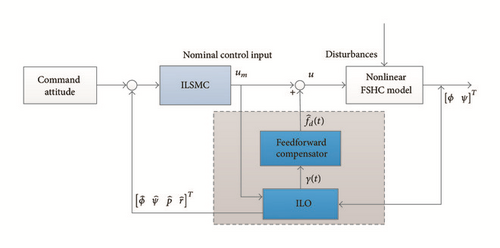
Assumption 2 (see [25]–[28], [37].)The nonlinear function ξ(·) is continuously differentiable and satisfies Lipschitz condition with Lipschitz constant σ; that is,
Remark 3. For marine vehicle systems, the high-order coupling hydrodynamics is sufficiently smooth. Therefore, it is reasonable that the nonlinear function ξ(·) satisfies Lipschitz condition.
Assumption 4. The disturbance fd(t) is bounded; namely, .
3. Output Feedback Control Design of the FSHV
3.1. Iterative Learning Observer Design
Remark 5. It can be seen from (8) that if the gain matrix μ1 is selected as a zero matrix, the ILO will degenerate into a conventional Luenberger observer. Therefore, zero matrix should be avoided for the gain tuning in order to maintain the capability of the estimation for the generalized disturbance.
Remark 6. It is necessary to clarify that the ILO input γ(t) proposed in (8) is not a discrete-time equation since the sampling time τ can be chosen as any value theoretically. τ used in the control design in Part B also matches this instruction, which can be further indicated by the Lyapunov function in stability analysis.
Remark 7. Compared with the conventional adaptive state observers, the proposed ILO has several advantages. It is able to estimate both system states and time-varying disturbance at the same time. Additionally, persistence of excitation (PE) is not required, which is necessary for the adaptive observers to update the estimation law online.
Theorem 8. Given the system dynamics in (7) with the proposed ILO designed in (8), the state estimate error is bounded if the following conditions hold:
Proof. Define the following Lyapunov function candidate:
Based on (9) and (12), differentiating V1 with respect to time yields
Substituting (11) into (15), we can obtain
If holds, the estimation error as well as the generalized disturbances is uniformly ultimately bounded (UUB) [38].
3.2. Observer Based Iterative Sliding Mode Controller Design
As to the controller design, an ILO based sliding mode controller is proposed for the output feedback course keeping control problem of the FSHV based on an iterative learning sliding surface. Before the controller design, we first make the following transformation.
Based on (24), the iterative learning sliding mode controller can be designed as follows.
Remark 9. According to (25), it is clear that if the time interval τ is chosen as τ = 0, the sliding surface will become , which is actually a conventional linear sliding surface. Hence, the existence of τ implies the improvement of the dynamic performance of the iterative learning sliding surface.
Let s = 0, then it yields
Differentiating V2 with respect to time yields
Substituting (26) into (28), we can obtain
Based on the proposed sliding surface, the control law χs can be designed as
Then the final control input u is obtained as
4. Stability Analysis
The closed-loop stability of the observer-controller structure of system (5) is analyzed in this part.
Theorem 10. Given the system model for the course keeping control of the FSHV in (5), with the ILO proposed in (8) and the feedback linearization based iterative learning sliding mode controller in (34), uniformly ultimate boundedness can be guaranteed for the closed-loop system at the equilibrium point.
Proof. The Lyapunov function of the closed-loop system is selected as
5. Simulation
In this section, a mathematical model of a FSHV [2, 3] is applied to validate the performance of the proposed approach. The physical parameters of the FSHV are given in Table 1.
| Parameter | Value | SI-unit |
|---|---|---|
| u0 | 23.15 | m/s |
| m | 2.62∗105 | kg |
| Ix | 2.59∗105 | kgm2 |
| Iz | 1.47∗107 | kgm2 |
|
|
0.025 | m |
| Kp | −13.0354∗105 | kgm2/s |
| Kr | −2.4864∗105 | kgm2/s |
| Krrϕ | −19.0883∗105 | kgm2/s |
| Krϕϕ | 12.5615∗105 | kgm2/s |
| Np | −0.2182∗107 | kgm2/s |
| Nr | −1.3818∗107 | kgm2/s |
| Nrrϕ | 0.9261∗107 | kgm2/s |
| Nrϕϕ | −1.5141∗107 | kgm2/s |
|
|
−1.046 | kgm2/s |
|
|
5.84 | kgm2/s |
|
|
0.3925 | kgm2/s |
|
|
−0.2308 | kgm2/s |
- (1)
Iterative learning observer based sliding mode controller (ILSMC): this is the observer based sliding mode control approach using iterative learning strategy proposed in the previous sections. In order to reduce the chattering phenomenon, a saturated function sat(·) is utilized instead of sgn(·). The control parameters are listed as follows:
(44) - (2)
Iterative learning observer with standard sliding mode controller (ILOSSMC): in this method, a standard sliding surface is used instead of the iterative learning sliding manifold to verify the advantage of the proposed control approach. In the ILOSSMC, Kτ = 0, and the other parameters are the same as the ILSMC.
- (3)
Linear extended state observer with standard sliding mode controller (LESOSSMC): in this method, the system model is linearized by an auxiliary feedback linearization approach. Based on this approach, a linear extended state observer (LESO) is designed to estimate system states as well as the generalized disturbances. The sliding mode controller design is similar to the ILOSSMC. The LESO is designed as follows:
(45)where x1 is the system output, , are the estimate values of x1, x2, and z3 is the extended state for the estimate of the generalized disturbances. The parameters of the LESO are selected as follows: l1 = 54, l2 = 189, and l3 = 3472.
The above control schemes are tested individually for the course keeping of the FSHV in two typical cases, namely, Case 1 (sea state 3, H1/3 = 1.5 m) and Case 2 (sea state 5, H1/3 = 3.8 m). Figures 3 and 4 show the stabilization of roll and yaw dynamics based on three control methods on the condition H1/3 = 1.5 m and H1/3 = 3.8 m, respectively. The rudder angle and aileron angle of the two cases are presented in Figures 5 and 6. From Figures 3–6, we can see that based on the online iterative optimization, the stabilization performance of the ILSMC is better than that of the LESOSSMC against wave disturbances, and the system consumption of the ILSMC does not increase. Comparing the ILSMC with the ILOSSMC, we can see that the iterative learning item in the sliding manifold (25) plays an important role in the system stabilization. Utilizing the learning item, the system control can be automatically regulated according to the tendency of the system trajectory, which decreases the conservation in control design.
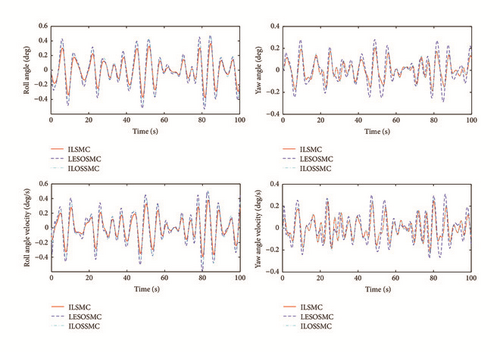
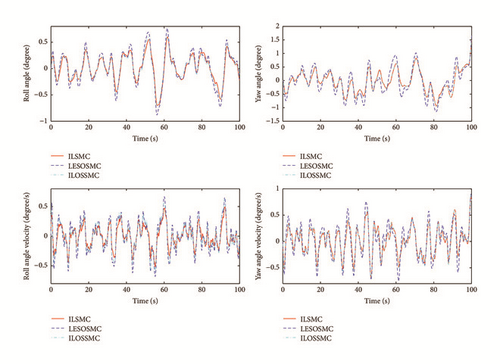
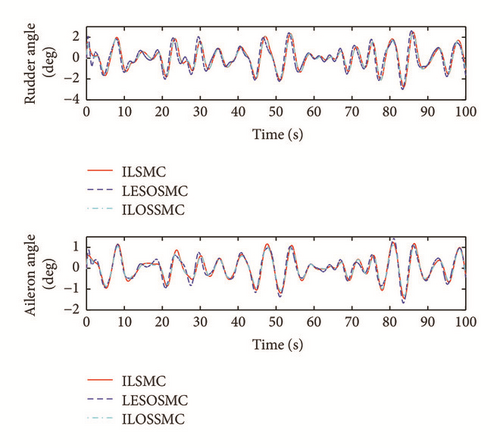

As to the state estimate, Figures 7 and 8 show the real system state and the state estimate of the ILO and the LESO in Case 1, and Figures 9 and 10 present the system estimate in Case 2. It can be shown from Figures 7–10 that the estimate accuracy of the ILO is higher than that of the LESO. Because of the high-gain character of the LESO, the peak phenomenon will occur if the observer gain selected is too large, while this problem will not happen in the ILO. Because of the design of γ(t) in the ILO, the estimating values can be updated dynamically according to the sample time τ, which enhances the state estimate precision for the system. In addition, γ(t) can detect the generalized disturbances and compensate them in the feedforward loop. The comparison of the disturbance estimate between the ILO and the LESO is illustrated in Figure 11 (Case 1) and Figure 12 (Case 2). It is illustrated that with the increase of the disturbances, the gaps in disturbances observing of the two methods become more obvious, which signifies the advantages of the ILO in severely perturbed systems. Using fixed observer gain, the ILO represents a self-adaptation property in state estimate, which achieves a better disturbance rejection performance than the LESO. The root mean square errors (RMSE) of the above state observers are listed in Table 2.
| RMSE |
|
|
|
|
|
|
|
|---|---|---|---|---|---|---|---|
| Case 1 | ILO | 0.164 | 0.088 | 0.161 | 0.092 | 0.048 | 0.004 |
| LESO | 0.215 | 0.122 | 0.219 | 0.126 | 0.049 | 0.006 | |
| Case 2 | ILO | 0.258 | 0.184 | 0.187 | 0.161 | 0.061 | 0.012 |
| LESO | 0.317 | 0.298 | 0.258 | 0.214 | 0.063 | 0.013 | |
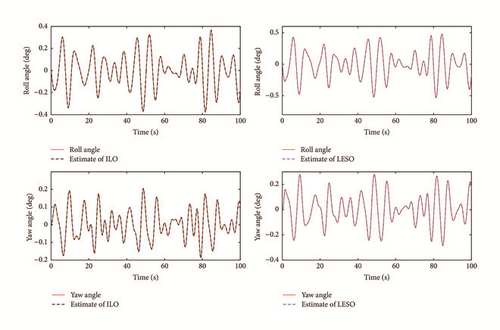

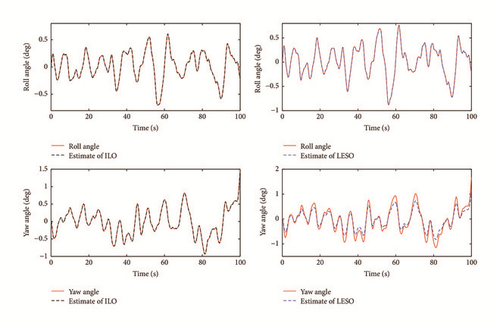
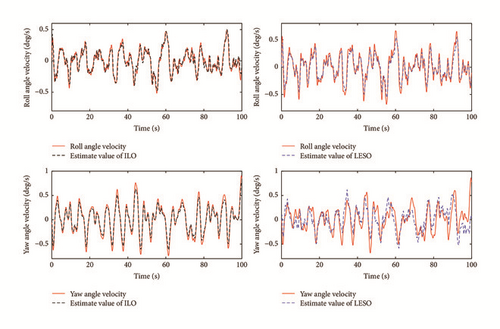
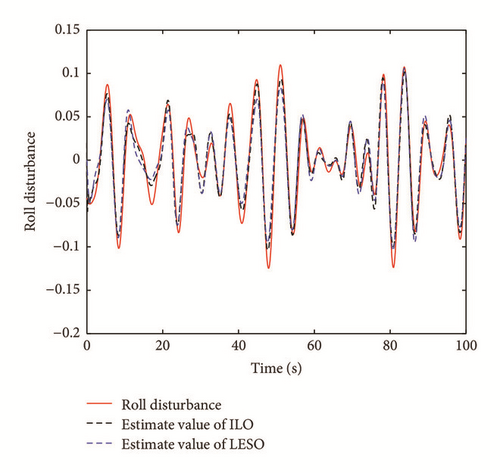
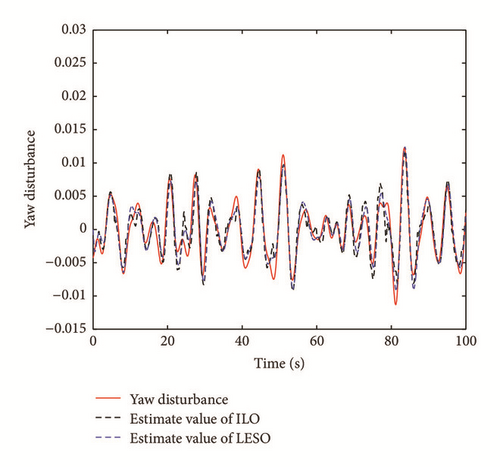
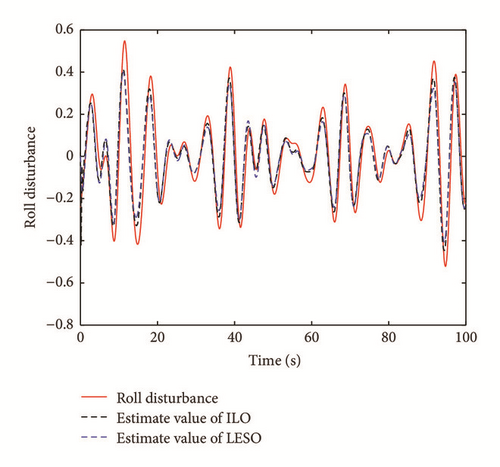
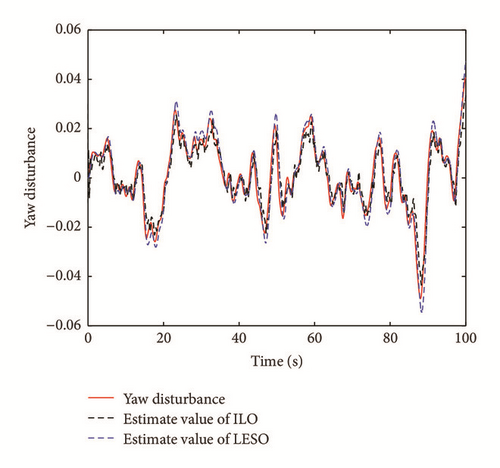
6. Conclusion
In this paper, an output feedback control scheme is investigated for the course keeping control of the fully submerged hydrofoil vessel based on an iterative learning strategy. An iterative learning observer is illustrated for the estimation of system states as well as the generalized disturbances. Then an iterative sliding model controller is established for the attitude stabilization of the fully submerged hydrofoil vessel. Based on the ILO, the disturbances can be estimated through the inner loop, and the iterative sliding mode controller attenuates the residual error of the estimated disturbances in the outer loop. Based on Lyapunov stability theory, uniformly ultimate boundedness of the overall closed-loop system is guaranteed. With the intervention of the iterative item, performance of the transient states can be improved for both state observer and controller. Comparative simulation results illustrate that the proposed approach achieves better estimate accuracy and disturbance rejection performance. The system conservation also decreases compared with conventional approaches. In future work, time-varying sampling time is to be considered based on the time scale and frequency characteristic of the system. And the control objective for the FSHV will extend to the kinematic level with goals such as path following and trajectory tracking.
Conflicts of Interest
The authors declare that there are no conflicts of interest regarding the publication of this paper.
Acknowledgments
This work is supported by National Natural Science Foundation of China under Grant 51579047.




